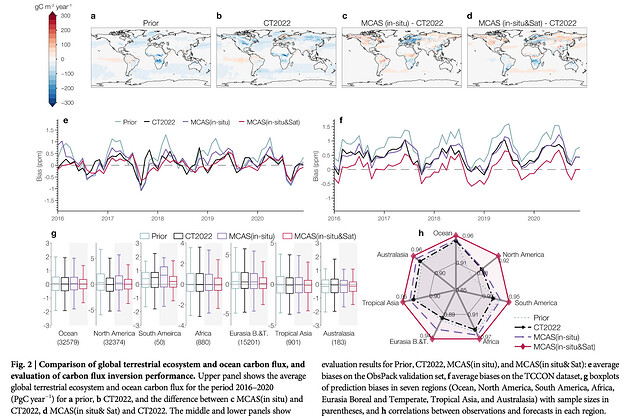A new global carbon flux estimation methodology by assimilation of both in situ and satellite CO2 observations
This week, we take a closer look at the paper that has been published in the Nature Portfolio Journal in Climate and Atmospheric Science. The study was led by Wu Su, from the Center for Big Data Research of Peking University in Beijing, China.
The success of global carbon mitigation initiatives crucially hinges on our ability to accurately quantify carbon removal by terrestrial ecosystems and oceans. The availability of multi-source CO2 observations, including in situ and satellite observations, offers prospects for an improved assessment of carbon fluxes. Yet their use has been so far limited due to their heterogeneity, which challenged their efficient aggregation. The multi-observation carbon assimilation system (MCAS) developed by the authors of this paper successfully combines diverse multi-source information to achieve a more precise estimation of carbon flux.
Combining both situ and satellite observations, the MCAS relies on a modified ensemble Kalman filter method to ensure the heterogeneity between data from different data sources is accounted for and balanced. The carbon fluxes estimated by the MCAS, yielding the global terrestrial ecosystem and ocean carbon fluxes with 3-hourly and 1° × 1° resolution from 2016 to 2020, show significant advantages over control experiments that assimilate one information source only. Compared to other carbon flux products, estimates obtained through the MCAS exhibit very low biases and show the smallest variability across all regions. Specifically, based on the RMSE evaluation from an independent in situ validation dataset, the error of the MCAS when assimilating both types of data was more than 15% lower than those assimilating data from a single source. The net land flux and ocean fluxes estimated using MCAS are consistent with those of the global carbon project.
A zoom-in on the main takehomes from this study:
- Accurately estimating carbon removal by terrestrial ecosystems and oceans is key to global carbon mitigation initiatives’ success
- Access to multi-source CO2 observations could lead to improved assessment of carbon fluxes, yet data heterogeneity across sources hinders their efficient assimilation
- The MCAS methodology harvests and combines diverse multi-source CO2 data, successfully overcoming the heterogeneity challenge.
- Estimates from the MCAS are consistent with the global carbon project estimates and prove more accurate, outperforming those obtained from a single source, with a sizeable reduction in error compared to existing carbon flux products
- These results suggest a new avenue for a more precise estimation of carbon flux
Read the full paper here: A new global carbon flux estimation methodology by assimilation of both in situ and satellite CO2 observations
